you are here: main page > timeline > Industrial era > 1993
![]()
![]()
![]()
![]()
![]()
you are here: main page > timeline
> Industrial era > 1993
|
The Industrial Era 1993 The pentium, a long waited new processor from INTEL. This is the year were many internet providers open for the public. |
pre history | antiquity |
pre industrial era | industrial
era
1947
- 1950 - 1952 - 1955
- 1958 - 1961 - 1963
- 1965 - 1969 - 1970
- 1972 - 1974 - 1976
1978 - 1980 -
1981 - 1982 - 1984 - 1986
- 1989 - 1991 - 1993
- 1994 - 1996 - 2000
- 2002
| Related Articles |
| Related Resources |
|
pre history |
![]() Intel introduces the Pentium
chip. (in fact it's Intel's 586) An increase of 200% in power of the processor,
as is announced by the manufacturers can not be realized. Tests showed that
even a 20% increase is not possible with the standard (386/486 or 64020/30/40)
available software. The Pentium is plagued with problems. For example a cooling
is mandatory because of problems with over heating.
Intel introduces the Pentium
chip. (in fact it's Intel's 586) An increase of 200% in power of the processor,
as is announced by the manufacturers can not be realized. Tests showed that
even a 20% increase is not possible with the standard (386/486 or 64020/30/40)
available software. The Pentium is plagued with problems. For example a cooling
is mandatory because of problems with over heating.
The pentium is the first cpu for micro computers with a kind of parallel processing.
The Pentium contains more than 1.5 million transistors. The production technology
makes it possible that the connection between the transistors are of 0.8 micron
width. There are developments ongoing to reduce this to 0.6 micron. This will
lead to less heat production and a lower energy consumption.
The dramatically falling prices of CPU's based on the 80486 processors are conquering
the market and replaces almost all PCs based on the older CPU. The standard
become a bigger hard disc (minimal 250 Mbit) and a quicker S(uper) VGA video
card with video accelerator chips and minimal 8 Mb RAM.
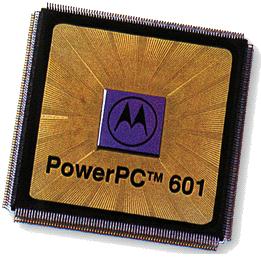
![]() Motorola and IBM introduce the
PowerPC 601. A joint effort by Motorola, DEC and Apple.
Motorola and IBM introduce the
PowerPC 601. A joint effort by Motorola, DEC and Apple.
However the processor can not deliver the promised increase of speed with 200%
in power, as is announced by the manufacturers. Tests showed that even a 20%
increase is not possible with the standard (386/486 or 64020/30/40) available
software.
The 601 contains over 2.8 million transistors and runs at 50 MHz, with a 0.6um between the transistors.
![]()
![]() is
founded by the National Science Foundation to provide registration and directory
services. (6)
is
founded by the National Science Foundation to provide registration and directory
services. (6)
![]() The White House (USA presidential
residence) goes online. President Clinton and Vice President Gore get email
addresses at the White House. This is the first time the White House has been
online. Clinton and Gore used email extensively in their 1992 presidential campaign.
(6)
The White House (USA presidential
residence) goes online. President Clinton and Vice President Gore get email
addresses at the White House. This is the first time the White House has been
online. Clinton and Gore used email extensively in their 1992 presidential campaign.
(6)
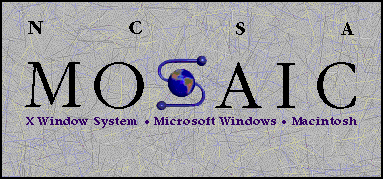
![]() Mosaic
released
Mosaic
released
University of Illinois undergraduate Marc Andreesen and a team of programmers
release a free Web browser called Mosaic. One of the first browsers available
to the general public.
World Wide Web usage grows at a phenomenal rate. In 1994, Andreesen will team up with Silicon Graphics founder James Clark to launch Netscape. (6)
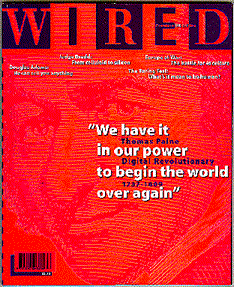 |
 |
| formal first issue cover (5) | first experimental cover (4) |
![]() January; Louis Rossetto and Jane
Metcalfe launch the first issue of Wired magazine. The magazine features jarring
colors and graphic design, and a hip, irreverent style that soon comes to be
identified with cyber-culture. (6)
January; Louis Rossetto and Jane
Metcalfe launch the first issue of Wired magazine. The magazine features jarring
colors and graphic design, and a hip, irreverent style that soon comes to be
identified with cyber-culture. (6)
![]() June; Adobe ships Acrobat, an
electronic document system designed to make it easier to distribute identical
copies of electronic documents. At first Adobe asked a steep price for its software
but a year later Adobe drops the 50 USD for its reader soon after that the software
will become inmensely popular.(2)
June; Adobe ships Acrobat, an
electronic document system designed to make it easier to distribute identical
copies of electronic documents. At first Adobe asked a steep price for its software
but a year later Adobe drops the 50 USD for its reader soon after that the software
will become inmensely popular.(2)
In 1995, IBM and Netscape both agree to support Adobe Acrobat, making it a widely
accepted format for viewing documents.(6)
![]() September; Stephen King releases
a story from his upcoming Nightmares and Dreamscapes short story collection
on the Internet. (6)
September; Stephen King releases
a story from his upcoming Nightmares and Dreamscapes short story collection
on the Internet. (6)
![]() Apple is markets a DOS compatible
computer. Still the high tech Apple remains very expensive. The advantage of
Apple's is that almost always as first the newest technology is included. Apple
chooses this year for another marketing strategy by lowering the prices drastically
and in addition produce a "cheaper" version (amongst them the "classic")
which recuperated some of the lost market share. This marketing strategy will
be followed by all: "A brand manufacturered like IBM and Compaq.
Apple is markets a DOS compatible
computer. Still the high tech Apple remains very expensive. The advantage of
Apple's is that almost always as first the newest technology is included. Apple
chooses this year for another marketing strategy by lowering the prices drastically
and in addition produce a "cheaper" version (amongst them the "classic")
which recuperated some of the lost market share. This marketing strategy will
be followed by all: "A brand manufacturered like IBM and Compaq.
![]() A new trend in Personal Computing
is to market PDA appliances: the so-called Personal Digital Assistant.
Because of the size of these computers this family is called: Palmtop, or handheld.
A new trend in Personal Computing
is to market PDA appliances: the so-called Personal Digital Assistant.
Because of the size of these computers this family is called: Palmtop, or handheld.
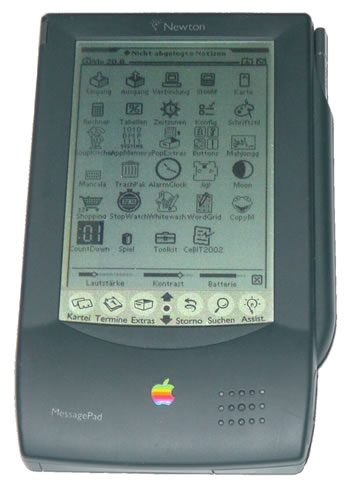
Apple Newton Messagepad
Important examples of these are: the Newton of Apple and the Zoomer of Casio/Tandy. PDAs are characterized that they do not have a keyboard but that they worked with a well developed graphical interface in which handwriting recognizing a key function has. For this there is developed a separate operating system: Pen-OS. With a (special) pen one can use the machine, icons are touched in order to start a function. Short notes can be made/written on the surface of the screen. The software will recognize the handwriting and convert this to machine writing. This recognition does not always work fool proof, sometimes even very bad.
Apple introduced the Newton Message Pad and set off the explosion of development in PDAs. The Message Pad itself didn't win over many customers and was dropped in 1998, but it showed that there is a market for such devices.
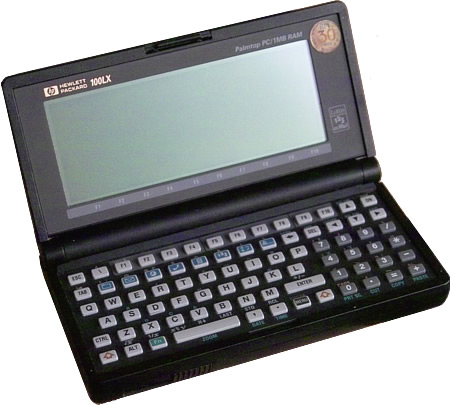
![]() Small is beautiful is the new
credo of manufacturers of computers. More and more sub-notebooks (IBM's Thinkjet,
HP's Omni-book) and hand held/hip held portables are marketed. Some of then
can work on penlight (A4 batteries) for at least 8 hours. Built-in software
covers in addition to the standard software (word processing, spreadsheets and
databases) also all kind of gadgets such as an address list, calculator and
a diary.
Small is beautiful is the new
credo of manufacturers of computers. More and more sub-notebooks (IBM's Thinkjet,
HP's Omni-book) and hand held/hip held portables are marketed. Some of then
can work on penlight (A4 batteries) for at least 8 hours. Built-in software
covers in addition to the standard software (word processing, spreadsheets and
databases) also all kind of gadgets such as an address list, calculator and
a diary.
![]() The consumer demands the same
processing power as the desk top models and want to work with the same
or compatible software. Operating hours on one set of batteries of less than
4 hours are not accepted.
The consumer demands the same
processing power as the desk top models and want to work with the same
or compatible software. Operating hours on one set of batteries of less than
4 hours are not accepted.
Because of the the consumer demands: more powerful computers, longer operating
hours and more expansion possibilities, the PCMCIA technology is boosted. Machines
at the size of a credit card ten or more millimeters thick do execute
all kind of functions: fax/modem, network interface, memory, even as a hard
disc. This kind of cards can be used without any problems in the specific slots
of the new note books.
![]() After many years Word Perfect
appears on the market with a new version of its text processor (version 6.0)
and drawing program (version 2.0). Surprisingly both are DOS versions and aimed
at multi media use and for the non-window's user. Both versions are mouse supported
and completely graphically. The word processor has many bugs varying from non
readable WPG files till crashing of the computer when the fax is used. WP only
replaces the software when the user is complaining., the user will receive a
free upgrade. But this strategy is not going to help the WP company to survive.
After many years Word Perfect
appears on the market with a new version of its text processor (version 6.0)
and drawing program (version 2.0). Surprisingly both are DOS versions and aimed
at multi media use and for the non-window's user. Both versions are mouse supported
and completely graphically. The word processor has many bugs varying from non
readable WPG files till crashing of the computer when the fax is used. WP only
replaces the software when the user is complaining., the user will receive a
free upgrade. But this strategy is not going to help the WP company to survive.
![]() The new version of MS-DOS (6.0)
appears on the market and is not very well received. Partly because there are
not many new additions to the DOS operating system. In addition, the majority
of the supporting programs are bought from others: usually old versions.
In comparison with the other programs on the market the functional use is meager
and causes problems with many users. Within 2 months MS was forced to market
a new version. The promised network support is and remains weak.
The new version of MS-DOS (6.0)
appears on the market and is not very well received. Partly because there are
not many new additions to the DOS operating system. In addition, the majority
of the supporting programs are bought from others: usually old versions.
In comparison with the other programs on the market the functional use is meager
and causes problems with many users. Within 2 months MS was forced to market
a new version. The promised network support is and remains weak.
![]() Novell (networks) buys DR-DOS
and soon it marketed a new version. Understandable the network support is perfectly
organized.
Novell (networks) buys DR-DOS
and soon it marketed a new version. Understandable the network support is perfectly
organized.
![]() IBM breaks its ties with Microsoft
and starts to go in competition by marketing new versions of PC-DOS.
IBM breaks its ties with Microsoft
and starts to go in competition by marketing new versions of PC-DOS.
![]() The CP/M operating system is
slowly disappearing.
The CP/M operating system is
slowly disappearing.
![]() The expansion of UNIX is threatened
by a copyright conflict. However, the OSF (Open Software Foundation) prevents
this, hence all versions of UNIX could be reasonable compatible. Unix is used
more and more in the administrative sector. Partly this is because the more
powerful PCs (memory, hard disk, CPU) and due its use of a graphic interface
with the so called X-window GUI. UNIX is becoming a bigger competitor of the
Novell/DOS environments because the system is more open for improvements made
by other parties (read: anyone) and many utilities can be bought or obtained
for free from various sources.
The expansion of UNIX is threatened
by a copyright conflict. However, the OSF (Open Software Foundation) prevents
this, hence all versions of UNIX could be reasonable compatible. Unix is used
more and more in the administrative sector. Partly this is because the more
powerful PCs (memory, hard disk, CPU) and due its use of a graphic interface
with the so called X-window GUI. UNIX is becoming a bigger competitor of the
Novell/DOS environments because the system is more open for improvements made
by other parties (read: anyone) and many utilities can be bought or obtained
for free from various sources.
![]() Another trend in the software
development is the merging of complete versions of existing programs in one
big program: called Office "..." or Smart "...". None of
the programs brings large improvements but the user can buy the software for
a relative low price, at least compared to the earlier pricing strategies. The
only guarantee is that every single module in the so called suite can read the
data from the other ones, mainly by using the technology that is part of the
Windows environment.
Another trend in the software
development is the merging of complete versions of existing programs in one
big program: called Office "..." or Smart "...". None of
the programs brings large improvements but the user can buy the software for
a relative low price, at least compared to the earlier pricing strategies. The
only guarantee is that every single module in the so called suite can read the
data from the other ones, mainly by using the technology that is part of the
Windows environment.
![]() As well as IBM (OS/2 2.1) as
Microsoft (Windows NT) are bringing their new Windows program on the market.
Both versions are not completely error free and are extremely slow when the
computer has anything less than a 486 or 68040 processor.
As well as IBM (OS/2 2.1) as
Microsoft (Windows NT) are bringing their new Windows program on the market.
Both versions are not completely error free and are extremely slow when the
computer has anything less than a 486 or 68040 processor.
![]() IBM has replaced the MS Windows
code with that of its own. This liberates IBM from paying license fees to Microsoft.
The window program can be used for OS/2 with minor alterations
IBM has replaced the MS Windows
code with that of its own. This liberates IBM from paying license fees to Microsoft.
The window program can be used for OS/2 with minor alterations
![]() The Window NT environment has
embedded the DOS operating system, hence no need anymore for a separate DOS
system.
The Window NT environment has
embedded the DOS operating system, hence no need anymore for a separate DOS
system.
![]() HP introduced the full fledged
"super portable" palm top alike computer: the HP OmniBook 300. The
computer still weighs ±1450 grams. A big advantage is that the computer can
work several hours on one set of penlight batteries.
HP introduced the full fledged
"super portable" palm top alike computer: the HP OmniBook 300. The
computer still weighs ±1450 grams. A big advantage is that the computer can
work several hours on one set of penlight batteries.
![]()
| Last Updated on July 27, 2004 | For suggestions please mail the editor in chief |
Footnotes & References